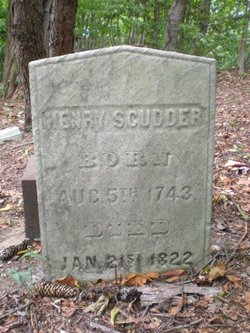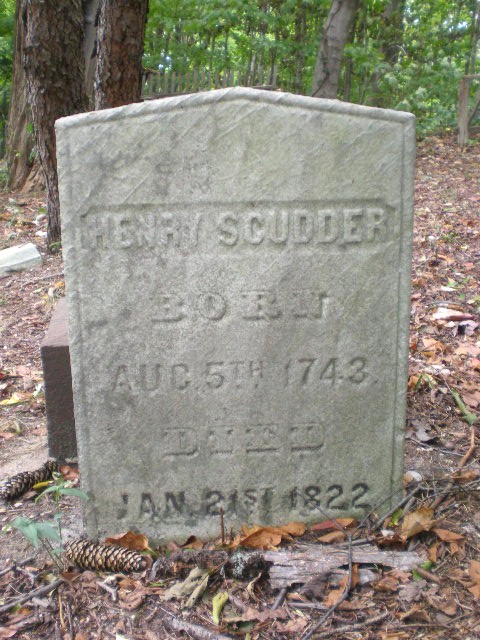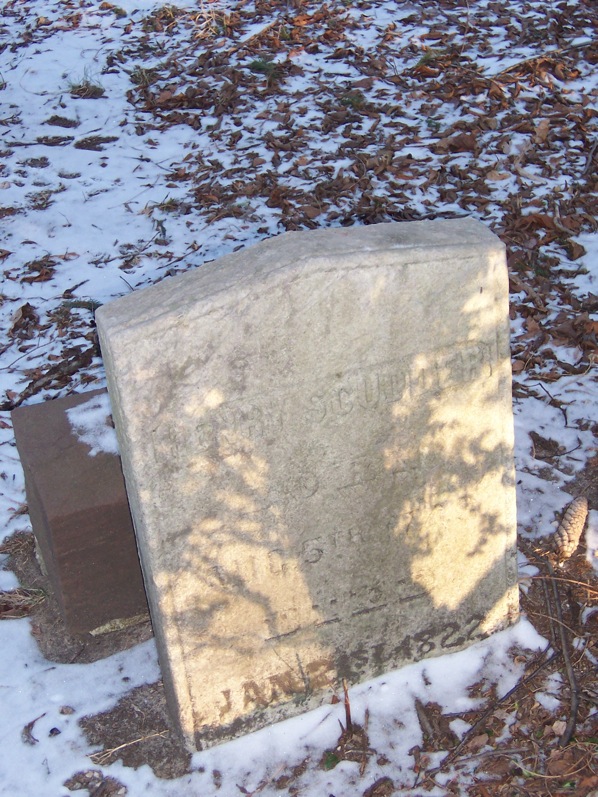Son of Timothy Scudder II & Mary Whitehead
Henry Scudder - Patriot of the American Revolution
[Huntington Historical Society]
By the time of the American Revolution, Henry Scudder, born in 1743, lived on a large farm near Crab Meadow. In 1774, he was selected to serve on the Town Committee, through which news of events in the other colonies was spread and plans for action were coordinated. At a General Town meeting on May 2, 1775, Henry Scudder was named 2nd Lieutenant in a company of 80 men chosen to be ready to march and fight.
A year later at the Battle of Long Island, Henry and his brother, 1st Lieutenant Joel Scudder were captured by the British. Henry was soon released. Joel was placed on the prison ship "Jersey" where he later died. By the time Henry returned home to Huntington, the British had established a garrison on the Village Green and every male over the age of 15 was compelled to take an Oath of Fealty to the British Crown. Like many others, Scudder fled to Connecticut rather than take the oath.
From Connecticut, Lieutenant Scudder planned and led numerous raids on Long Island intended to deprive the British of supplies and to provide captured supplies to Washington's army. He was an operative in the famous Culper Spy Ring that operated clandestinely on Long Island and New York City feeding critical information to General Washington during the American Revolution. They gathered information of the various British forts on Long Island. In 1781, Scudder provided the sketch (made by Nathaniel Skidmore) detailing the layout of Fort Slongo. The fort stood just across the town line in Smithtown near his Crab Meadow farm.
In October 1781, the British were preparing a fleet in New York City to assist the troops trapped in Yorktown, Va. The patriots had hope to create a diversion, which would keep the fleet in New York. Following an attack plan by Colonel Benjamin Talmadge, 100 American raiders armed with Scudder's drawing, rowed across the Long Island Sound from Connecticut to Crab Meadow Beach on the night of October 2, 1781. Early the next morning the Americans caught the British completely by surprise and chased them off into the woods. The Americans burned the fort and the British fleet stayed in New York.
While there was no loss of life, the sergeant who led the American charge – Elijah Churchill of Enfield, Connecticut – was wounded. To recognize his heroism, George Washington created the Badge of Military Merit, now known as the Purple Heart.
Sgt. Churchill was its first recipient.
Scudder's activities almost resulted in his capture or death many times. Once he hid in the chimney of his house while a British officer threatened to kill his wife if she did not turn him in. Scudder's wife did not betray him, and the officer did not follow through on the threat. But as he left, the officer said, "If I don't find your rebel husband in a week, I'll be in my coffin." The words turned out to be true. In less than a week, Scudder and a party of 'rebels' surrounded a house where the officer was playing cards. He shot the officer and took sixteen prisoners.
Around 1790, Henry moved to the head of Northport Harbor. He built a home on the high ground just off today's Route 25A. The house remained in the Scudder family, until it was torn down in 1968.
Henry Scudder was a member of the convention that framed the State Constitution. He also represented Suffolk County for several terms in the State Legislature.
He died in 1822 and is buried next to his wife in the Old Northport Cemetery on the south side of Route 25A, a short walk from his home.
There is a historical marker that commemorates the patriot with a 1788 quote from New York Governor DeWitt Clinton that Scudder was "a brave and honest man."
[Huntington Historical Society - 209 Main Street, Huntington, NY 11743]
Son of Timothy Scudder II & Mary Whitehead
Henry Scudder - Patriot of the American Revolution
[Huntington Historical Society]
By the time of the American Revolution, Henry Scudder, born in 1743, lived on a large farm near Crab Meadow. In 1774, he was selected to serve on the Town Committee, through which news of events in the other colonies was spread and plans for action were coordinated. At a General Town meeting on May 2, 1775, Henry Scudder was named 2nd Lieutenant in a company of 80 men chosen to be ready to march and fight.
A year later at the Battle of Long Island, Henry and his brother, 1st Lieutenant Joel Scudder were captured by the British. Henry was soon released. Joel was placed on the prison ship "Jersey" where he later died. By the time Henry returned home to Huntington, the British had established a garrison on the Village Green and every male over the age of 15 was compelled to take an Oath of Fealty to the British Crown. Like many others, Scudder fled to Connecticut rather than take the oath.
From Connecticut, Lieutenant Scudder planned and led numerous raids on Long Island intended to deprive the British of supplies and to provide captured supplies to Washington's army. He was an operative in the famous Culper Spy Ring that operated clandestinely on Long Island and New York City feeding critical information to General Washington during the American Revolution. They gathered information of the various British forts on Long Island. In 1781, Scudder provided the sketch (made by Nathaniel Skidmore) detailing the layout of Fort Slongo. The fort stood just across the town line in Smithtown near his Crab Meadow farm.
In October 1781, the British were preparing a fleet in New York City to assist the troops trapped in Yorktown, Va. The patriots had hope to create a diversion, which would keep the fleet in New York. Following an attack plan by Colonel Benjamin Talmadge, 100 American raiders armed with Scudder's drawing, rowed across the Long Island Sound from Connecticut to Crab Meadow Beach on the night of October 2, 1781. Early the next morning the Americans caught the British completely by surprise and chased them off into the woods. The Americans burned the fort and the British fleet stayed in New York.
While there was no loss of life, the sergeant who led the American charge – Elijah Churchill of Enfield, Connecticut – was wounded. To recognize his heroism, George Washington created the Badge of Military Merit, now known as the Purple Heart.
Sgt. Churchill was its first recipient.
Scudder's activities almost resulted in his capture or death many times. Once he hid in the chimney of his house while a British officer threatened to kill his wife if she did not turn him in. Scudder's wife did not betray him, and the officer did not follow through on the threat. But as he left, the officer said, "If I don't find your rebel husband in a week, I'll be in my coffin." The words turned out to be true. In less than a week, Scudder and a party of 'rebels' surrounded a house where the officer was playing cards. He shot the officer and took sixteen prisoners.
Around 1790, Henry moved to the head of Northport Harbor. He built a home on the high ground just off today's Route 25A. The house remained in the Scudder family, until it was torn down in 1968.
Henry Scudder was a member of the convention that framed the State Constitution. He also represented Suffolk County for several terms in the State Legislature.
He died in 1822 and is buried next to his wife in the Old Northport Cemetery on the south side of Route 25A, a short walk from his home.
There is a historical marker that commemorates the patriot with a 1788 quote from New York Governor DeWitt Clinton that Scudder was "a brave and honest man."
[Huntington Historical Society - 209 Main Street, Huntington, NY 11743]
Family Members
Advertisement
Explore more
Sponsored by Ancestry
Advertisement











